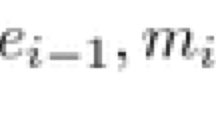Abstract
The success of Bovens and Hartmann’s recent “impossibility result” against Bayesian Coherentism relies upon the adoption of a specific set of ceteris paribus conditions. In this paper, I argue that these conditions are not clearly appropriate; certain proposed coherence measures motivate different such conditions and also call for the rejection of at least one of Bovens and Hartmann’s conditions. I show that there exist sets of intuitively plausible ceteris paribus conditions that allow one to sidestep the impossibility result. This shifts the debate from the merits of the impossibility result itself to the underlying choice of ceteris paribus conditions.
Similar content being viewed by others
Notes
Following B&H’s lead, I will refer to the conjunction of (BC2[i]) and (BC2[ii]) as (BC[2]).
B&H require witnesses to be independent in the sense that “R i screens off REPR i from all other fact variables R j and from all other report variables REPR j ” (2003, 16).
In this paper, I follow B&H in using italics to denote variables and non-italics to denote the values of variables; e.g., the variable R 1 can take on two values, R1 and ¬R1. Also following B&H, commas denote conjunction; thus, P(R1,…,Rn) = P(R1&…&Rn).
See B&H (2003)’s appendix A.1 for the derivation of this form of Bayes’s theorem.
There is an important distinction to be made here: B&H assume for simplicity that all information sources are equally reliable within an information set, and—as already noted—they assume for ceteris paribus’ sake that information sources are equally reliable across information sets; thus, r is only given one general value in these examples, which represents the level of reliability of all information sources for all information items across all information sets in question.
B&H offer the following example: “for an information triple containing the propositions R1, R2, and R3: a 2 = P(¬R1,¬R2,R3) + P(¬R1,R2,¬R3) + P(R1,¬R2,¬R3). That is, a 2 is the sum of the joint probabilities of all combinations with two negative values and one positive value.” Note that a 0 will always equal what B&H call the “expectedness of the information” for any information set, and the sum of the elements of any weight vector is always equal to one.
This counter-example, in and of itself, only shows that (BC1) and (BC2) are inconsistent for information triples. B&H note this and proceed to show that their result extends more generally to information sets where n > 3.
One might respond with the insight that B&H’s reliability ceteris paribus condition does not entail the equality of true positives between sets—i.e., B&H’s reliability condition says that one should only compare sets for which r := 1 − P(REPRi|¬Ri)/P(REPRi|Ri) is equal; however the ratio P(REPRi|¬Ri)/P(REPRi|Ri) could of course be equal between sets even if the true positives P(REPRi|Ri)were unequal. Nonetheless, B&H do seem to require ultimately that not only must the ratios be equal across sets but also the true and false positives themselves: “To keep things simple, let us assume that all witnesses are equally reliable, i.e., p i = p and q i = q for all i = 1,…,n” (B&H, 15). Additionally, it just seems to make good intuitive sense to hold true positive rates (and false positive rates) constant in our ceteris paribus conditions; indeed, Shogenji (2006) even argues that the true positive rate on its own could be taken to be a proper measure of witness reliability. Regardless, the above response is not necessarily relevant anyway as it is no longer B&H’s specific ceteris paribus conditions that we need to have in mind at this point.
Thanks very much to Luc Bovens, Clark Glymour, Stephan Hartmann, Tomoji Shogenji, Greg Wheeler, and especially to Adam True Bendorf for helpful correspondence.
References
Bovens, L., & Hartmann, S. (2006). An impossibility result for coherence rankings. Philosophical Studies, 128, 77–91.
Bovens, L., & Hartmann, S. (2005). Why there cannot be a single probabilistic measure of coherence. Erkenntnis, 63, 361–374.
Bovens, L., & Hartmann, S. (2003). Bayesian epistemology. Oxford: Oxford University Press.
Shogenji, T. (2006). Review of Luc Bovens and Stephan Hartmann, Bayesian epistemology. Theoria, 72, 166–171.
Shogenji T. (1999). Is coherence truth conducive? Analysis, 59(4), 338–345.
Author information
Authors and Affiliations
Corresponding author
Rights and permissions
About this article
Cite this article
Schupbach, J.N. On the alleged impossibility of Bayesian Coherentism. Philos Stud 141, 323–331 (2008). https://doi.org/10.1007/s11098-007-9176-y
Received:
Accepted:
Published:
Issue Date:
DOI: https://doi.org/10.1007/s11098-007-9176-y




